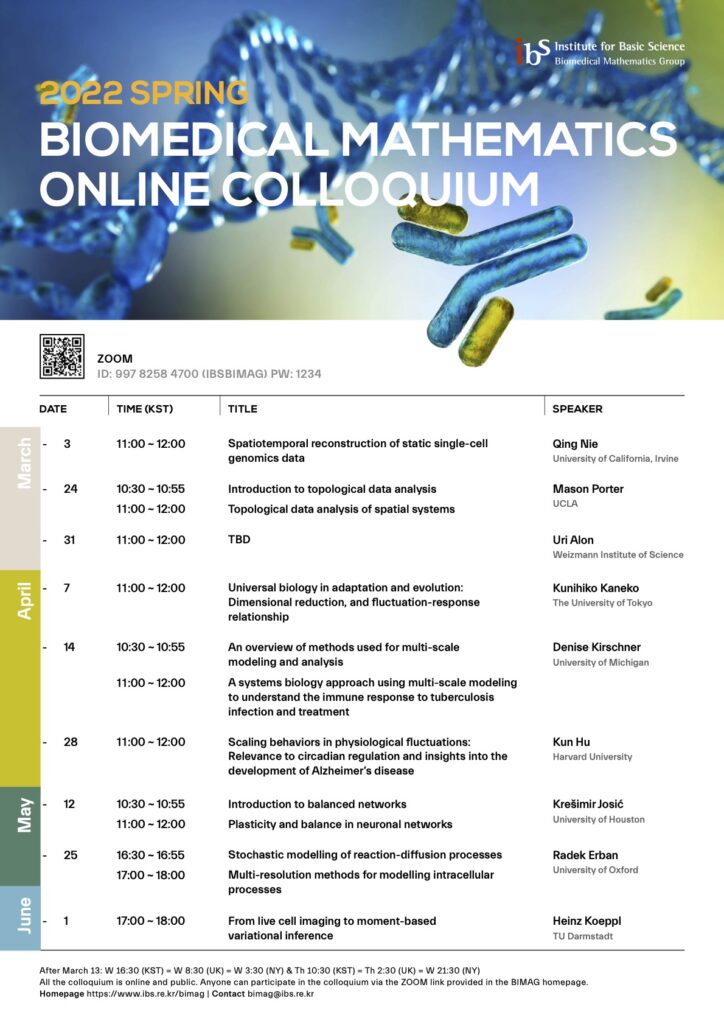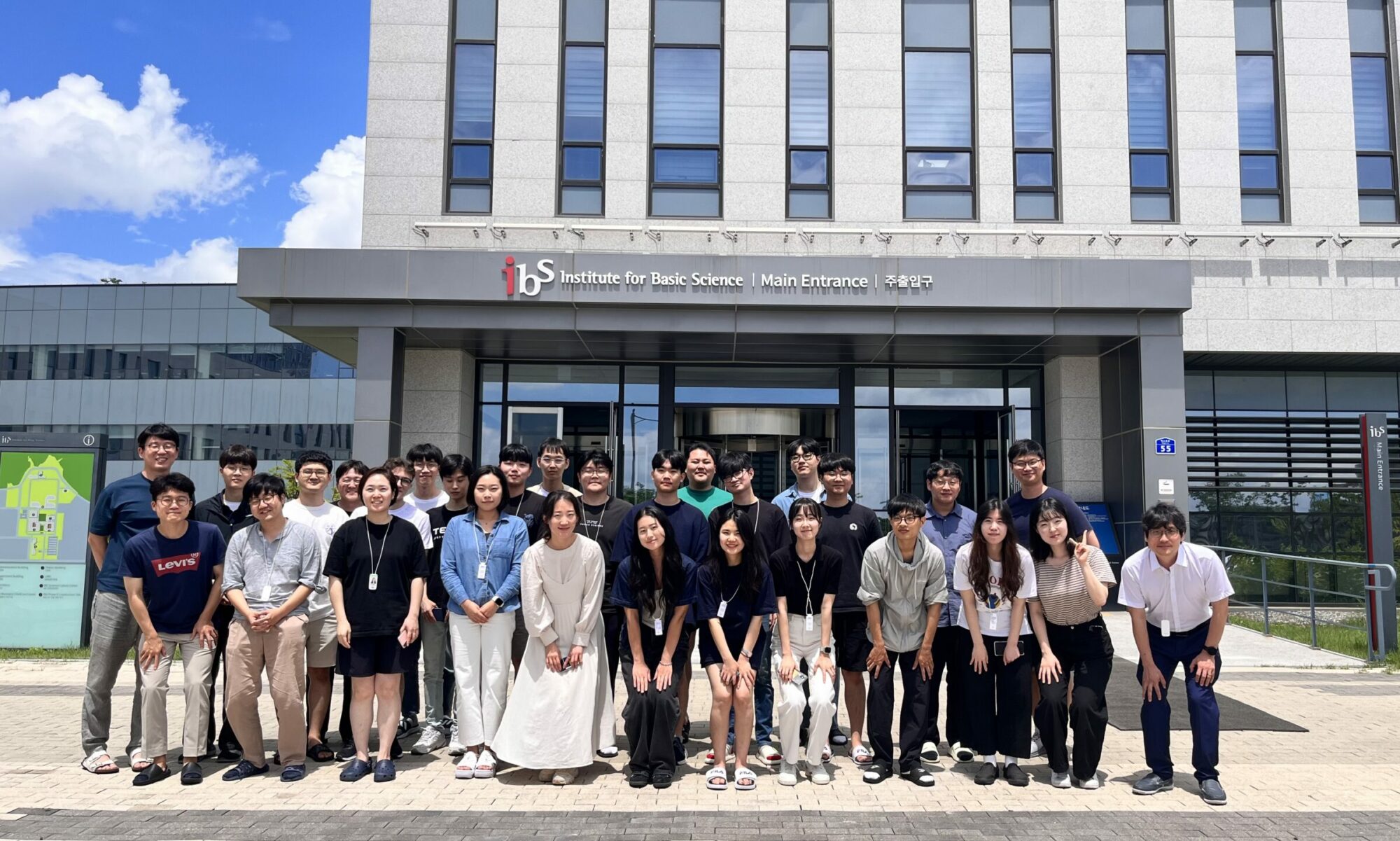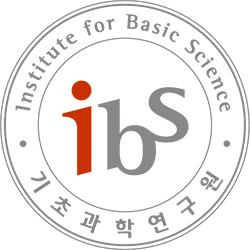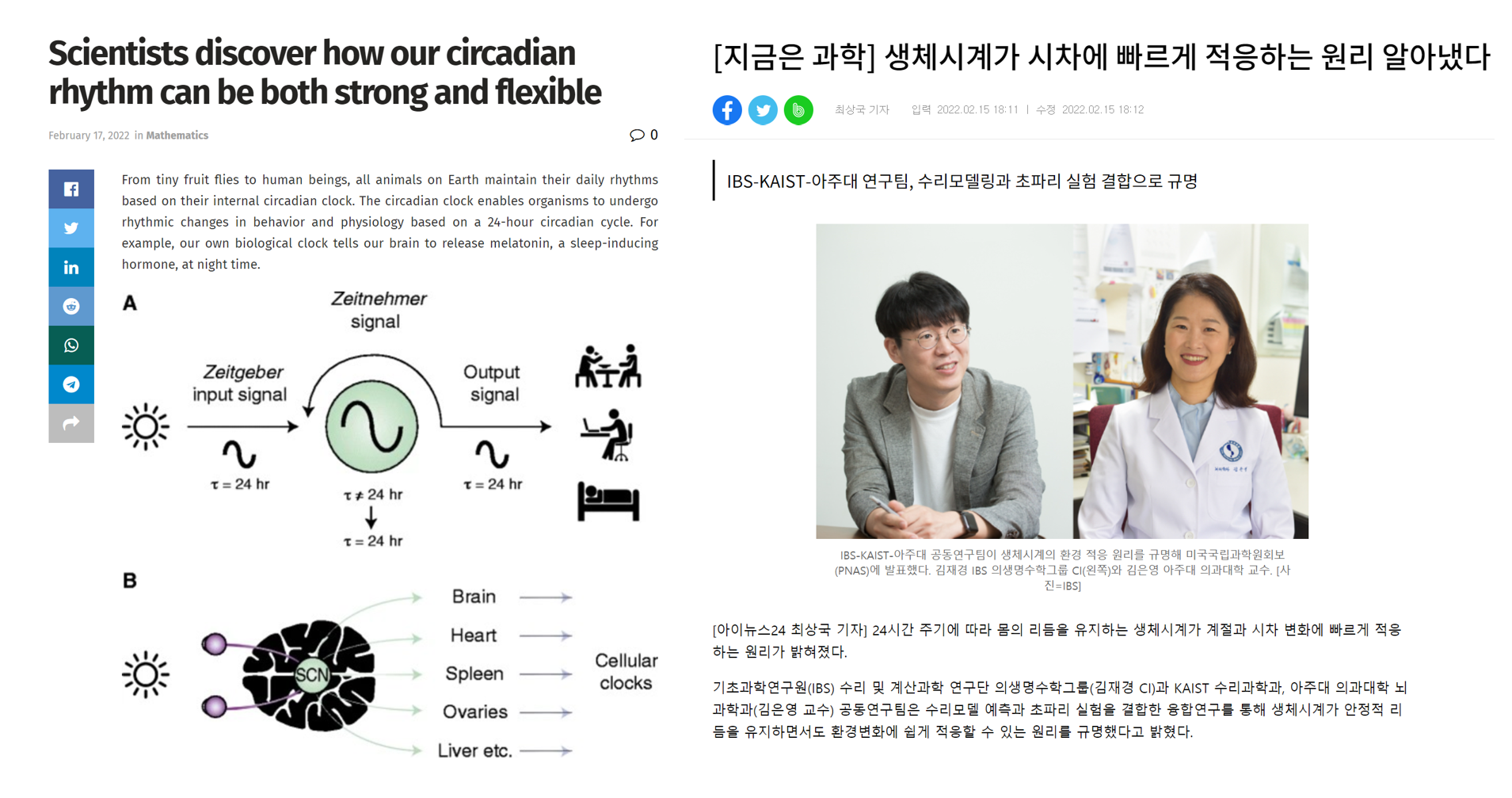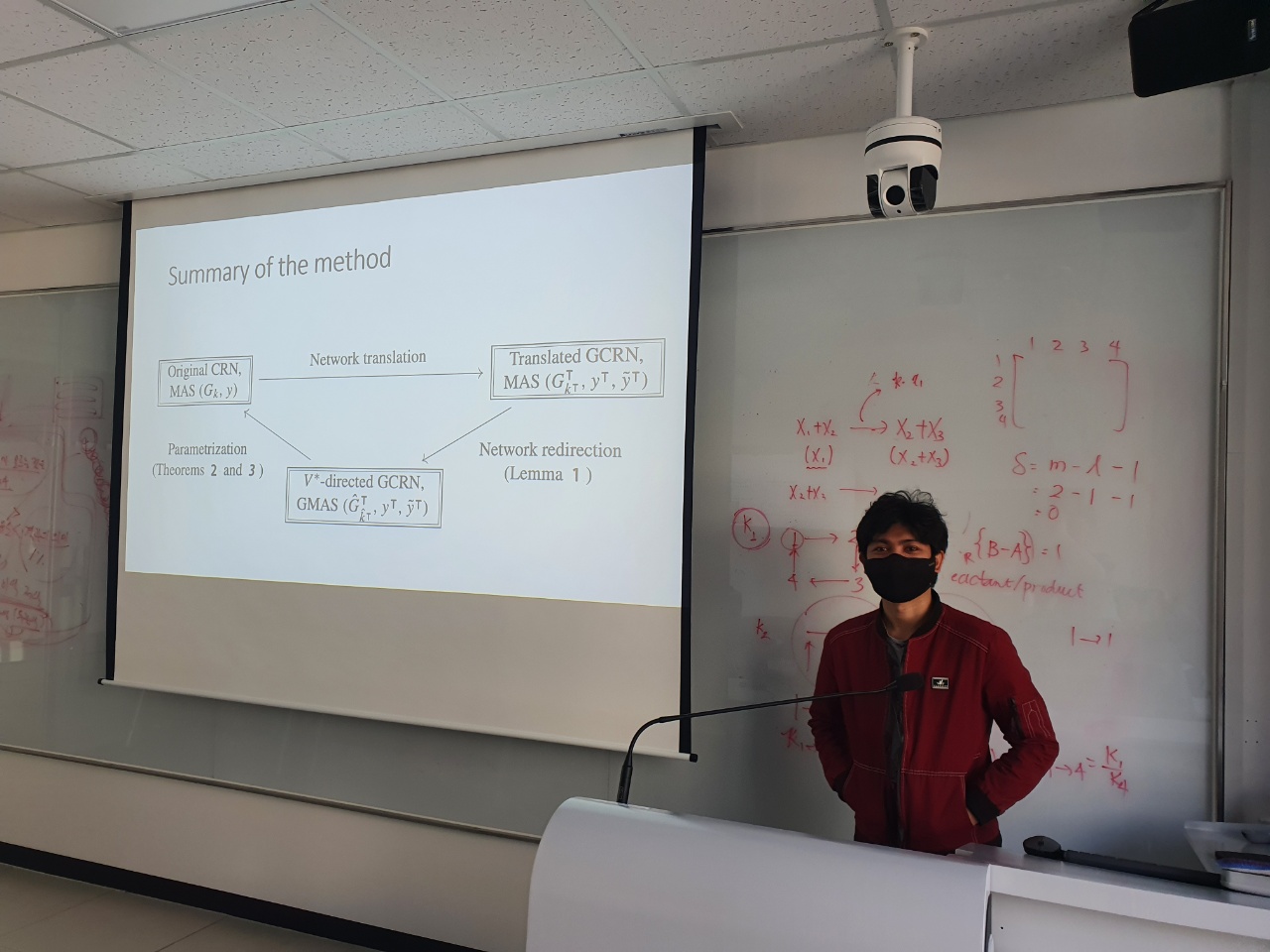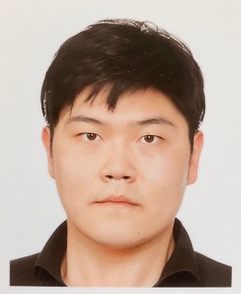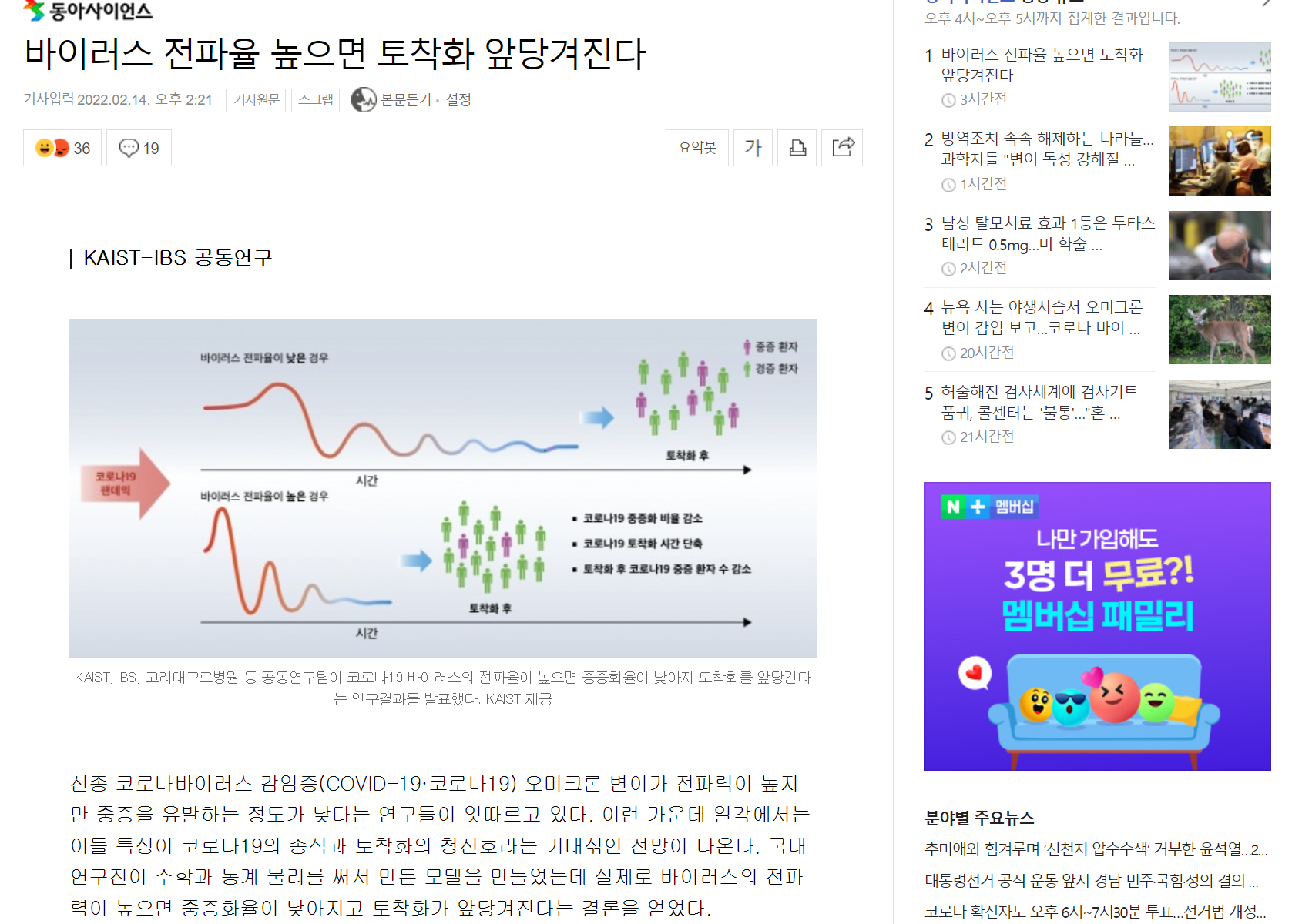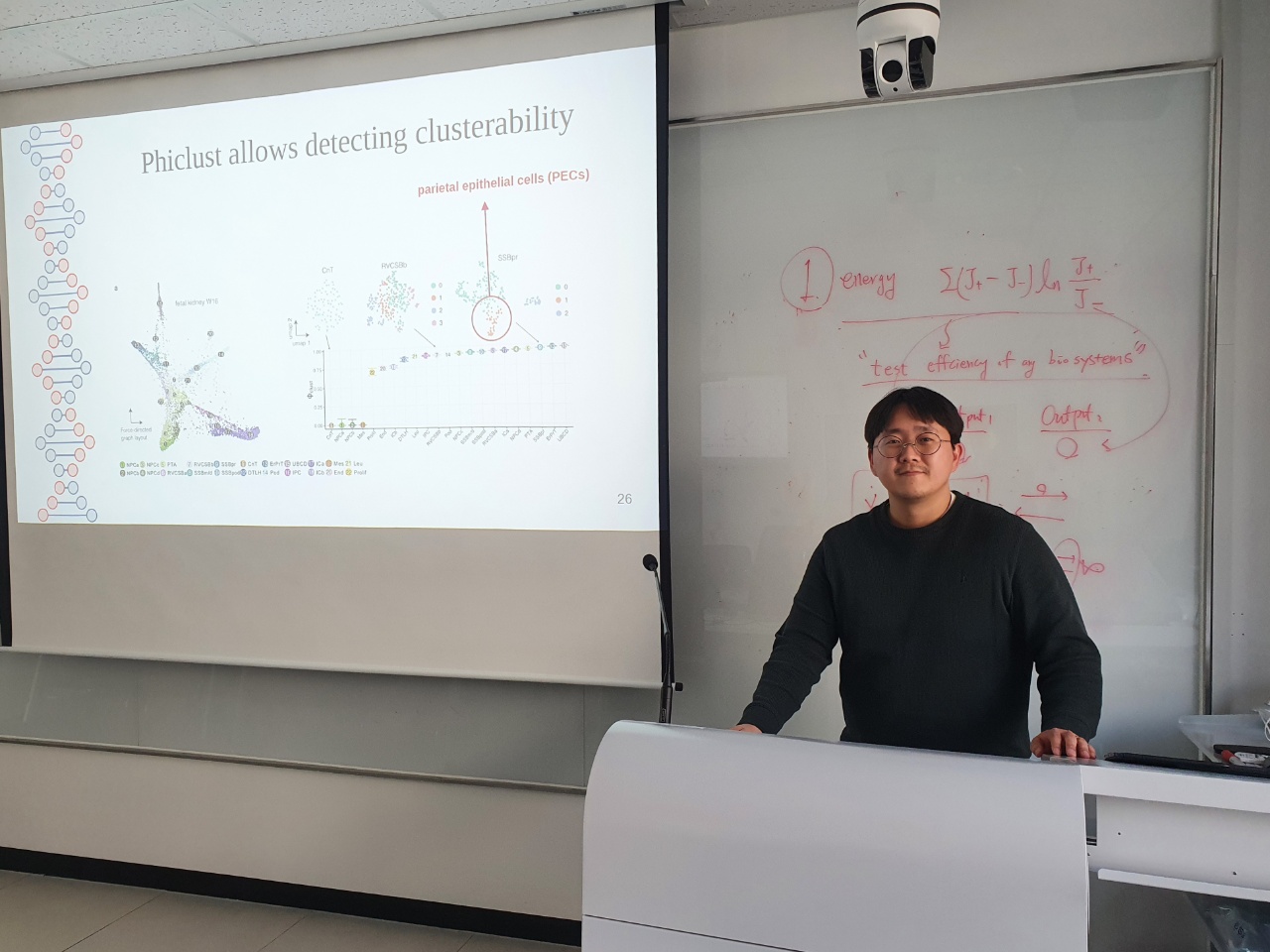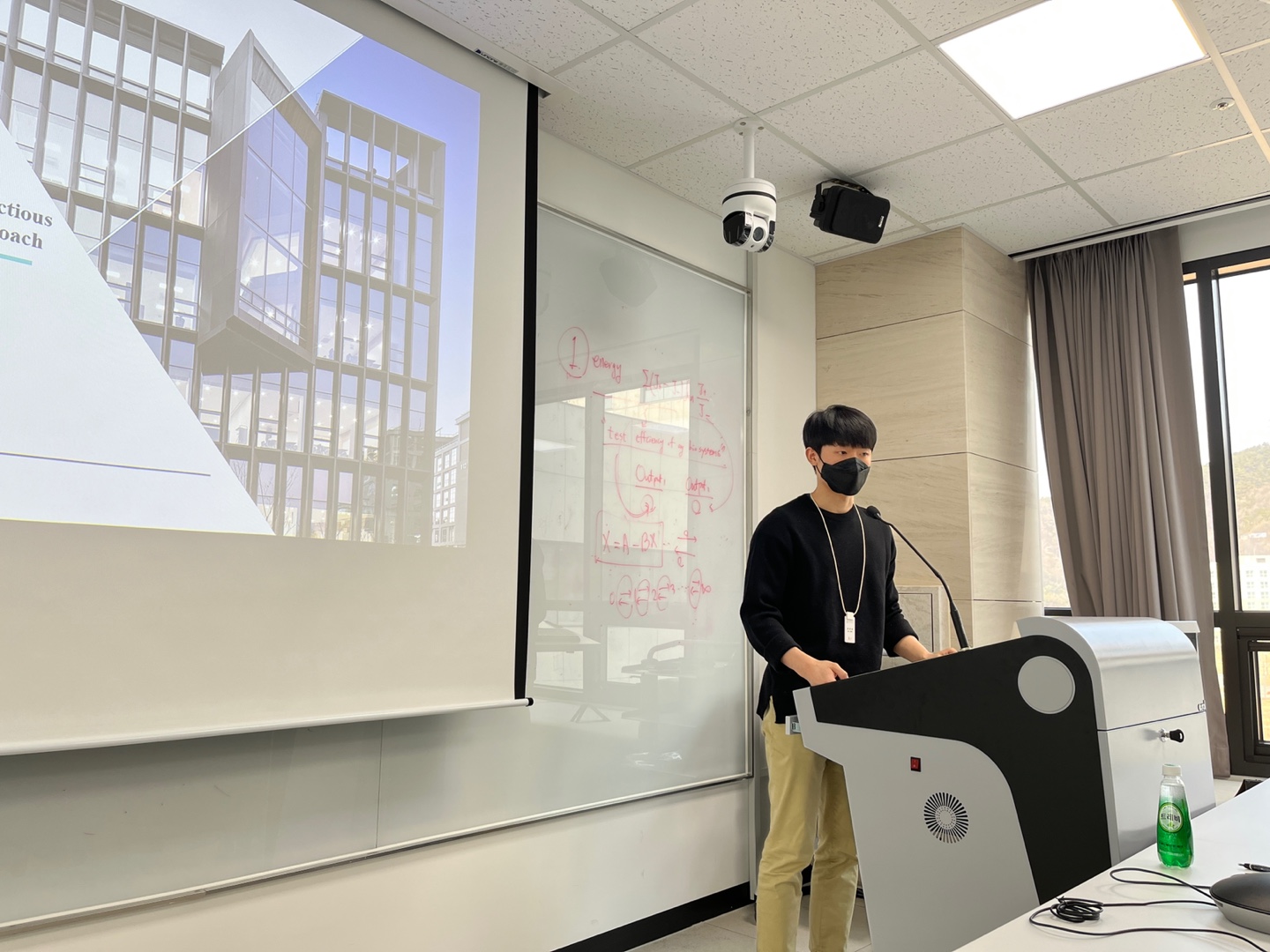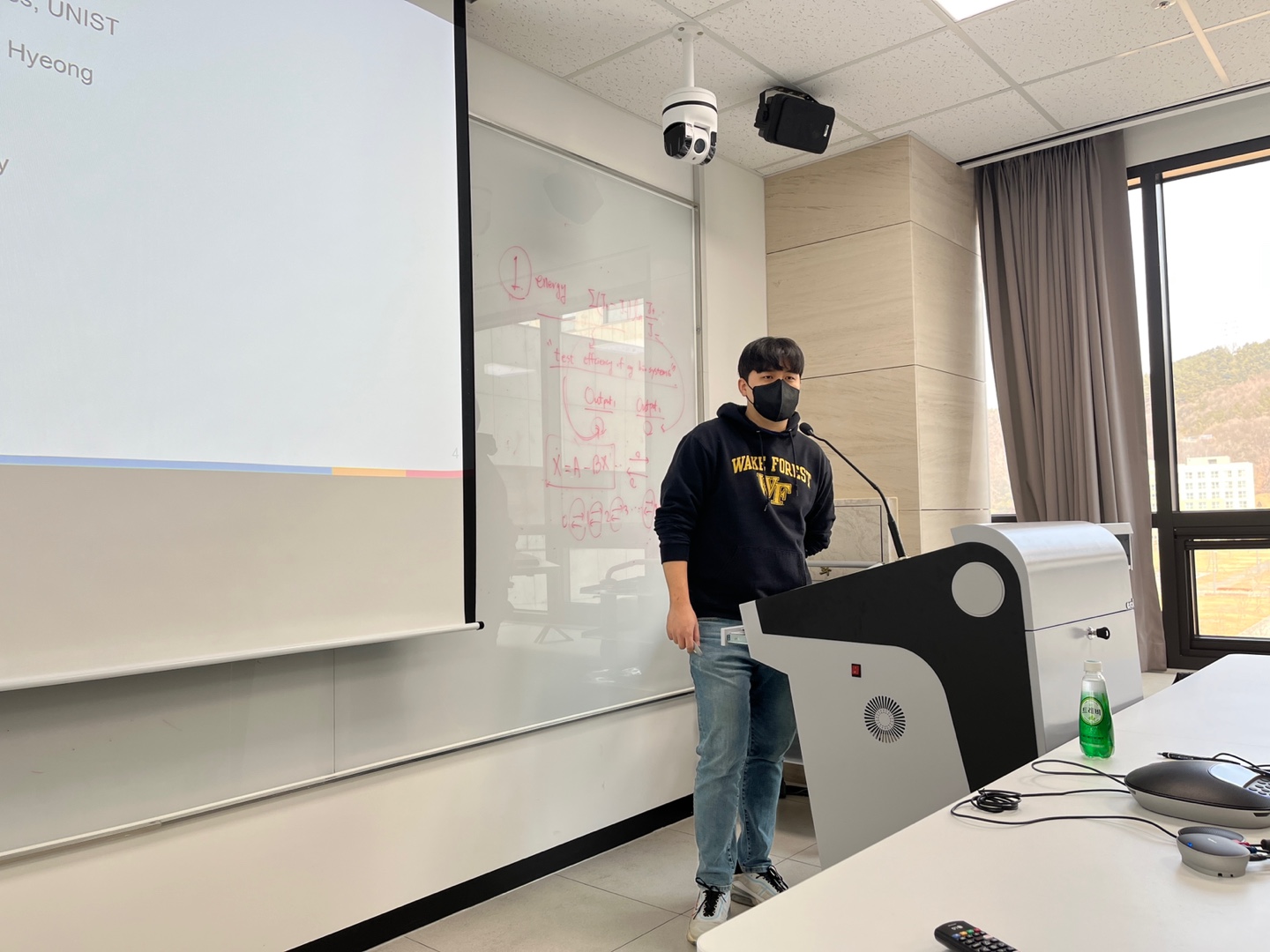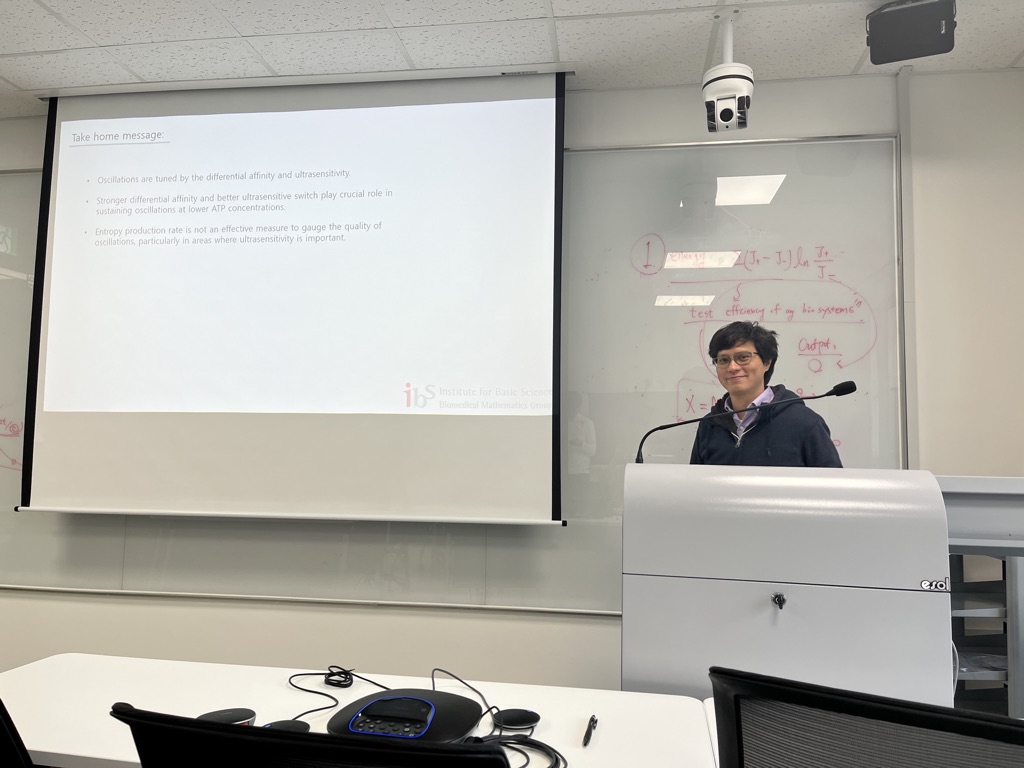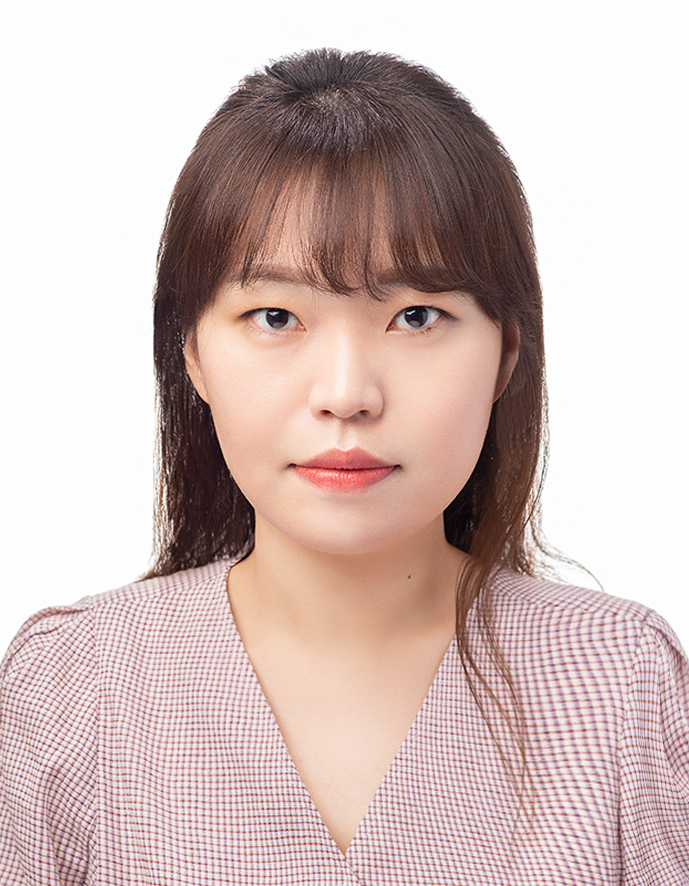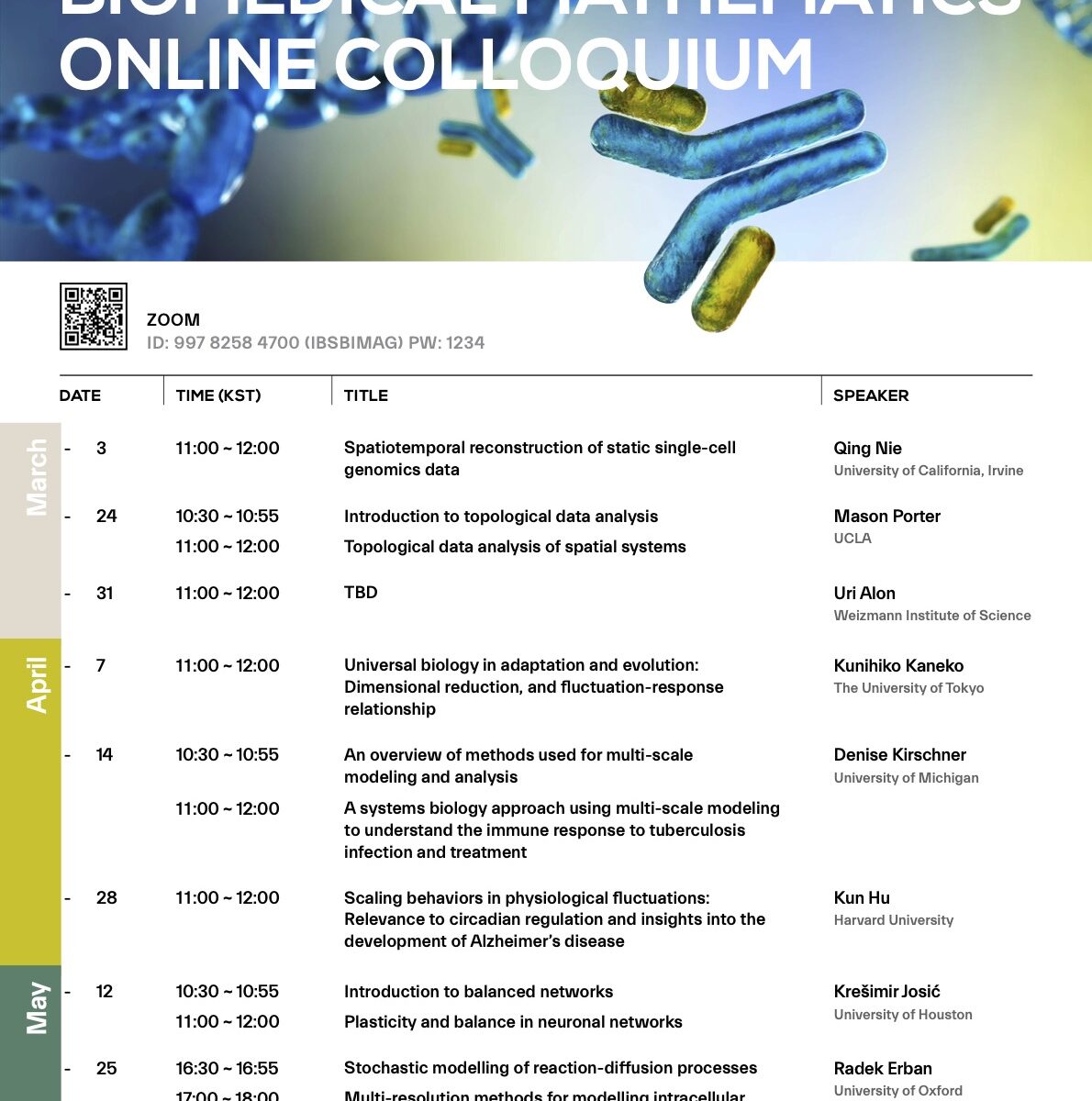Led by Prof. KIM Jae Kyoung and KIM Eun Young, researchers at the Institute for Basic Science (IBS) and Ajou University found that the master clock and the slave clock operate via different molecular mechanisms. Thanks to the distinct property of the master clock neurons, it is able to easily adapt to the new diurnal cycle.
기초과학연구원(IBS) 수리 및 계산과학 연구단 의생명수학그룹(김재경 CI)과 KAIST 수리과학과, 아주대 의과대학 뇌과학과(김은영 교수) 공동연구팀은 수리모델 예측과 초파리 실험을 결합한 융합연구를 통해 생체시계가 안정적 리듬을 유지하면서도 환경변화에 쉽게 적응할 수 있는 원리를 규명했다고 밝혔다. 연구팀은 이번 연구에서 초파리의 마스터 뉴런이 슬레이브 뉴런에 비해 PER 단백질의 합성과 분해 속도가 훨씬 빠르다는 것을 알아냈다. 또한 마스터 뉴런이 평소에는 동기화된 강한 리듬을 유지하다가 외부 환경 변화(시차)가 일어났을 때, 비동기화 되면서 리듬을 약하게 만들어 유연하게 환경 변화에 적응할 수 있음을 밝혔다.
[SCIENMAG] [아이뉴스24] – News
[논문 링크 (클릭)] – Paper
Bryan Hernandez gave a talk on “A Deficiency-Based Approach to Parametrizing Positive Equilibria of Biochemical Reaction Systems” at the Journal Club
On February 18, 2022, Bryan Hernandez gave a talk on “A Deficiency-Based Approach to Parametrizing Positive Equilibria of Biochemical Reaction Systems”, Johnston et al., Bulletin of Mathematical Biology, 2019
Welcome our new member!
Dr. Hyeontae Jo (Senior Researchers) have joined our group on February 16, 2021.
Dr. Hyeontae Jo received his math Ph.D. from POSTECH and has been a postdoctoral researcher at Basic Science Research Institute, POSTECH. He has researched differential equations and Machine learning.
High viral transmission amongst populations with high vaccination coverages accelerates the endemic transition of COVID-19 / 바이러스 전파율 높으면 토착화 앞당겨진다
KAIST, IBS, 고려대구로병원 등 공동연구팀이 코로나19 바이러스의 전파율이 높으면 중증화율이 낮아져 토착화를 앞당긴다는 연구결과를 발표했다. KAIST 수리과학과의 김재경 교수(IBS 의생명수학그룹 연구책임자)와 홍혁표 석박사통합과정 연구원, 노지윤 고려대구로병원 감염내과 교수, 신의철 KAIST 의과학대학원 교수 (IBS 한국바이러스기초연구소 바이러스면역연구센터장) 연구팀은 수리 모델을 통해 바이러스 전파율이 올라가면 궁극적으로 코로나19 위중증화율이 떨어진다는 사실을 확인했다고 14일 밝혔다.
Researchers from KAIST, IBS, Korea University Guro Hospital, etc., revealed that high viral transmission unexpectedly accelerates the endemic transition of COVID-19 with reduced numbers of severe cases. On February 14th, a research team including Jae Kyoung Kim (principal investigator of the BIMAG, IBS), Hyukpyo Hong (Ph.D. student), Ji Yun Noh (professor of Korea University Guro Hospital), and Eui-Cheol Shin (professor of KAIST Graduate School of Medical Science and Engineering), said that they demonstrated high viral transmission of COVID-19 paradoxically reduces the rates of progression to severe COVID-19 and accelerates the endemic transition, based on mathematical modeling.
[동아사이언스 뉴스 전문 (클릭)] – News
[논문 링크 (클릭)] – Paper
Hyun Kim gave a talk on “Phiclust: a clusterability measure for single-cell transcriptomics reveals phenotypic subpopulations” at the Journal Club
On February 11, 2022, Hyun Kim gave a talk on “Phiclust: a clusterability measure for single-cell transcriptomics reveals phenotypic subpopulations”, Mircea et al., Genome Biology, 2022
Yongin Choi gave a talk titled “Analysis of epidemic disease control using mathematical models” at the IBS Biomedical Mathematics Seminar
On February 08, 2022, Yongin Choi from UNIST gave a talk at the IBS Biomedical Mathematics Seminar. The title of his talk was “Analysis of epidemic disease control using mathematical models.”
Slghi Kim gave a talk titled “Stochastic Modeling of Foot and Mouth Diseases with Vehicle Network & Assessment of Social Distancing for Controlling COVID-19 in Korea” at the IBS Biomedical Mathematics Seminar
On February 08, 2022, Slghi Kim from UNIST gave a talk at the IBS Biomedical Mathematics Seminar. The title of his talk was “Stochastic Modeling of Foot and Mouth Diseases with Vehicle Network & Assessment of Social Distancing for Controlling COVID-19 in Korea.”
Aurelio A. de los Reyes V gave a talk on “Mechanisms for the generation of robust circadian oscillations through ultrasensitivity and differential binding affinity” at the Journal Club
On February 4, 2022, Aurelio A. de los Reyes V gave a talk on “Mechanisms for the generation of robust circadian oscillations through ultrasensitivity and differential binding affinity”, Behera, Junco, and Vaikuntanathan, The Journal of Physical Chemistry B, 2021
Minhye Kim joined our group as a visiting student.
On 4 February 2022, Minhye Kim, a graduate student studying under the supervision of Prof. Yongkuk Kim, from Kyungpook national university joined our group as a visiting student. She will stay until 28 February 2022.
2022 Spring Biomedical Mathematics Online Colloquium has been scheduled!
There will be nine fascinating online colloquium talks presented by pioneering researchers. Welcome to join via Zoom ID: 997 8258 4700 (PW: 1234). Please check the detailed schedule below. We will update our BIMAG website if there is any change in the schedule.
